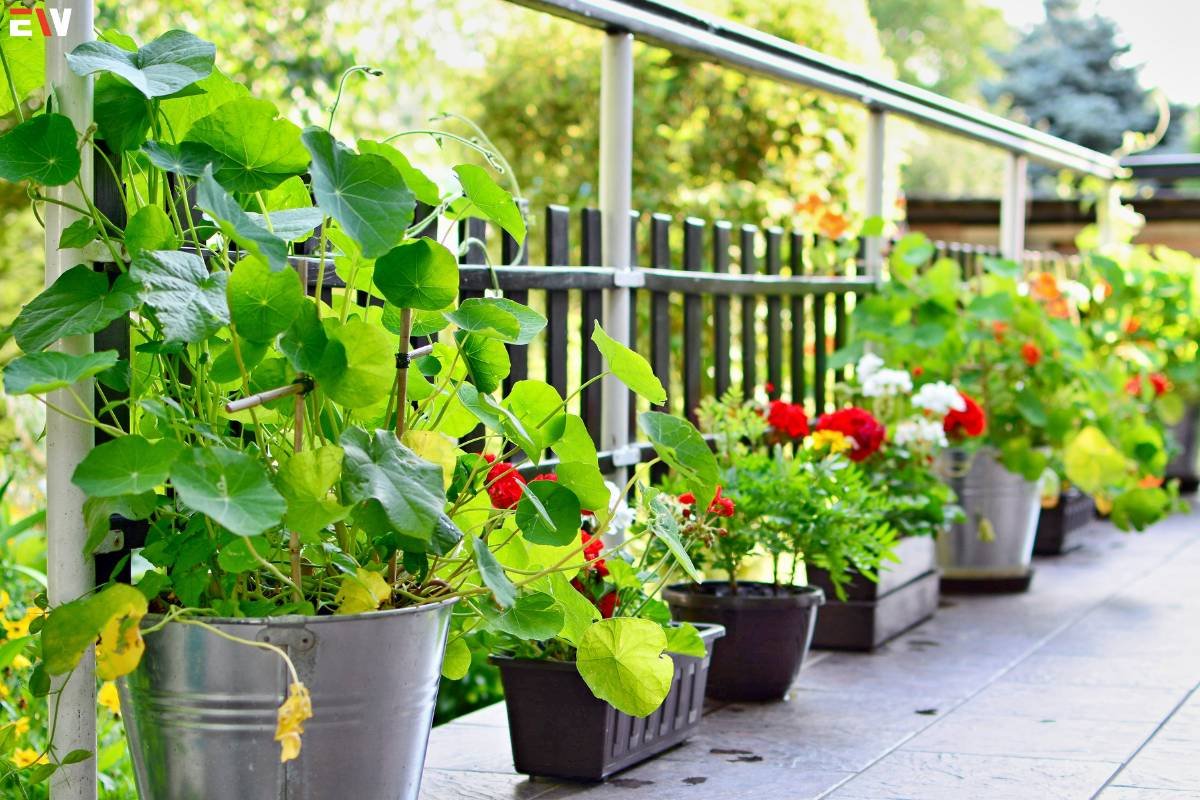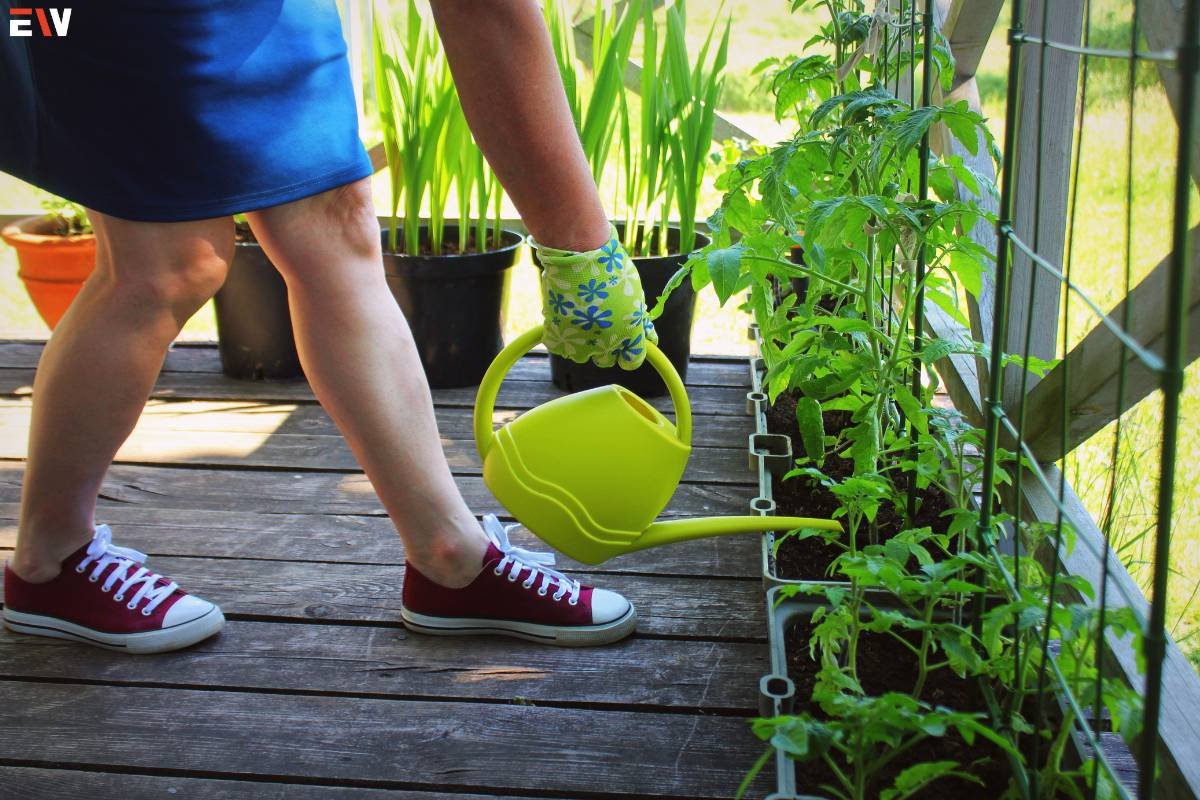Creating a thriving garden on your terrace is a fulfilling and eco-friendly endeavor that allows you to make the most of your rooftop space. Whether you have a green thumb or are new to gardening, these ten tried-and-true tactics will guide you toward successful gardening on terrace.
Here are 10 tactics for gardening on terrace:
1. Assess Your Terrace Space
Begin your journey to terrace gardening by thoroughly assessing your rooftop space. Consider the unique conditions of your terrace, including the amount of sunlight it receives, exposure to wind, available area, and its weight-bearing capacity. These factors are crucial in determining the type of garden you can establish.
For example, if your terrace receives direct sunlight for most of the day, you can grow sun-loving plants like tomatoes, peppers, and sunflowers. In contrast, a partially shaded terrace may be better suited for shade-loving plants like ferns, hostas, and impatiens.
2. Select Suitable Containers

The choice of containers is pivotal for your gardening on terrace. Opt for containers that are lightweight, durable, and well-suited for your plants. Some popular container materials include plastic, terracotta, fiberglass, or even repurposed items like wooden crates or metal tubs. Ensure that your chosen containers have proper drainage holes to prevent waterlogging, which can harm your plants.
Consider the size and style of your containers. Larger containers provide more room for plant roots to grow, but they may be heavier and take up more space. Elevated containers, such as planters on stands or wall-mounted planters, can be an excellent choice to save space and minimize strain on your back.
3. Soil Mix and Quality
Invest in a high-quality potting mix designed for container gardening on terrace. This mix should have excellent drainage properties and be rich in organic matter. You may need to supplement your potting mix with compost to ensure your plants receive essential nutrients.
The key is to use a mix that retains moisture without becoming waterlogged. Proper soil preparation is crucial because container plants rely on the potting mix for their nutrients and water supply.
4. Plant Selection
When it comes to selecting plants, it’s essential to choose varieties that thrive in the specific conditions of your terrace. Consider the amount of sunlight, wind exposure, and climate your terrace experiences.
Herbs like basil, rosemary, and mint are ideal for sunny terraces and provide fresh ingredients for your kitchen. If you have limited sunlight, consider ferns, hostas, or peace lilies to create a lush, green oasis. Flowering plants like petunias, marigolds, and zinnias are great choices for adding color to your terrace.
Vegetables like tomatoes, peppers, and lettuce can be successfully grown on a sunny terrace. If you have limited space, dwarf fruit trees like citrus or figs are also suitable for container gardening.
5. Watering and Drainage

Gardening on terrace requires consistent watering to keep your plants healthy and vibrant. However, it’s essential not to overwater, as this can lead to root rot and other issues. To ensure proper watering:
- Use a watering schedule that aligns with your plant’s specific needs. Some plants prefer to dry out slightly between waterings, while others like consistently moist soil.
- Ensure that your containers have good drainage to prevent waterlogging. Elevate containers slightly or use pot feet to allow excess water to escape.
- Water your plants in the early morning or late evening when temperatures are cooler. Watering during these times minimizes water loss through evaporation.
6. Organic Pest Control
Pests can be a challenge in any garden, but organic pest control methods can help you manage them effectively. Instead of harsh chemical pesticides, consider using natural alternatives:
- Neem oil is an effective and natural insect repellent. Mix it with water and a few drops of dish soap to create a spray that discourages common garden pests like aphids, mealybugs, and spider mites.
- Garlic-based sprays can deter a wide range of garden pests. Simply blend garlic cloves with water, strain the mixture, and spray it on your plants.
- Beneficial insects like ladybugs, lacewings, and parasitic wasps can help keep harmful pests in check.
Regularly inspect your plants for signs of pests, such as chewed leaves or discolored foliage. Early detection and prompt action can prevent pest infestations from becoming a significant problem.
7. Pruning and Deadheading
Regular pruning and deadheading are essential practices for maintaining the health and aesthetics of your terrace garden. Pruning involves cutting back overgrown or dead branches and foliage. Deadheading is the removal of spent or faded flowers. Both practices help:
- Encourage healthy growth: Pruning stimulates new growth, leading to a fuller and more attractive plant.
- Prolong blooming: Deadheading encourages plants to produce more flowers, extending the period of color and beauty in your garden.
- Prevent overcrowding: Removing excess growth prevents overcrowding and enhances air circulation, reducing the risk of disease.
8. Sun and Shade Management

Sunlight is a critical factor in your terrace garden’s success. The amount of sunlight your terrace receives will significantly impact the types of plants you can grow. Here’s how to manage sun and shade effectively:
- Full sun: A terrace that receives direct sunlight for most of the day is ideal for sun-loving plants. Vegetables like tomatoes, peppers, and eggplants, as well as herbs like basil and rosemary, thrive in full sun.
- Partial shade: If your terrace has areas with partial shade, consider shade-tolerant plants like ferns, hostas, and impatiens. You can also use shade-loving annuals and perennials to add color and greenery.
- Plant placement: Position your containers strategically to make the most of the available sunlight. Group sun-loving plants together and place them in the sunniest spots, while reserving shadier areas for shade-tolerant plants.
9. Fertilization
Container plants rely on you for their nutrient supply. Use a balanced, slow-release fertilizer to provide essential nutrients to your plants. Be cautious not to over-fertilize, as this can lead to nutrient imbalances and potential damage to your plants.
Fertilize your plants according to the instructions on the product label, which will usually recommend feeding every four to six weeks during the growing season. Over-fertilization can result in excessive leafy growth at the expense of flowering and fruiting, so moderation is key.
10. Regular Maintenance
Gardening on terrace, like any gardening endeavor, requires regular maintenance to keep your garden thriving. Here are some maintenance tasks to incorporate into your routine:
- Weeding: Regularly inspect your containers for weeds and remove them promptly to prevent them from competing with your plants for resources.
- Pruning and deadheading: As mentioned earlier, pruning and deadheading are essential for encouraging healthy growth and prolonged blooming.
- Monitoring plant health: Keep an eye on your plants for any signs of stress or disease. Early intervention can prevent issues from spreading and causing severe damage.
- Soil maintenance: Refresh the potting mix in your containers every year or as needed to ensure your plants have access to vital nutrients.
Remember that maintaining your terrace garden is not just about plant care but also about creating a space that you can enjoy and relax in. Regularly tidying up and tending to your garden enhances its visual appeal and your overall garden experience.
A Flourishing Terrace Garden
Overall, gardening on terrace is a deeply satisfying endeavor that allows you to transform your rooftop into a thriving











